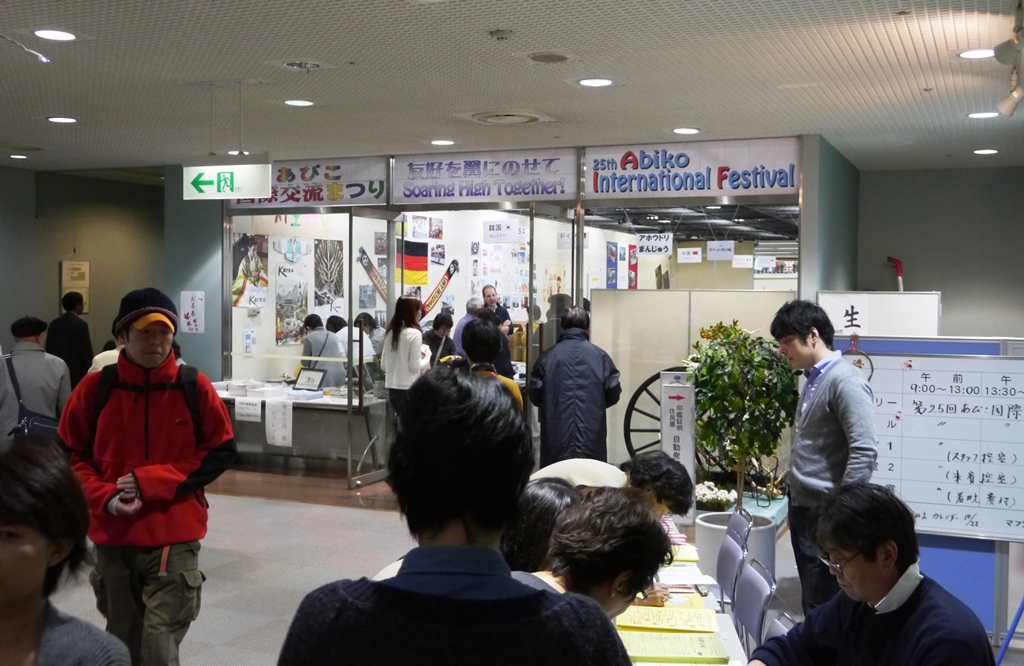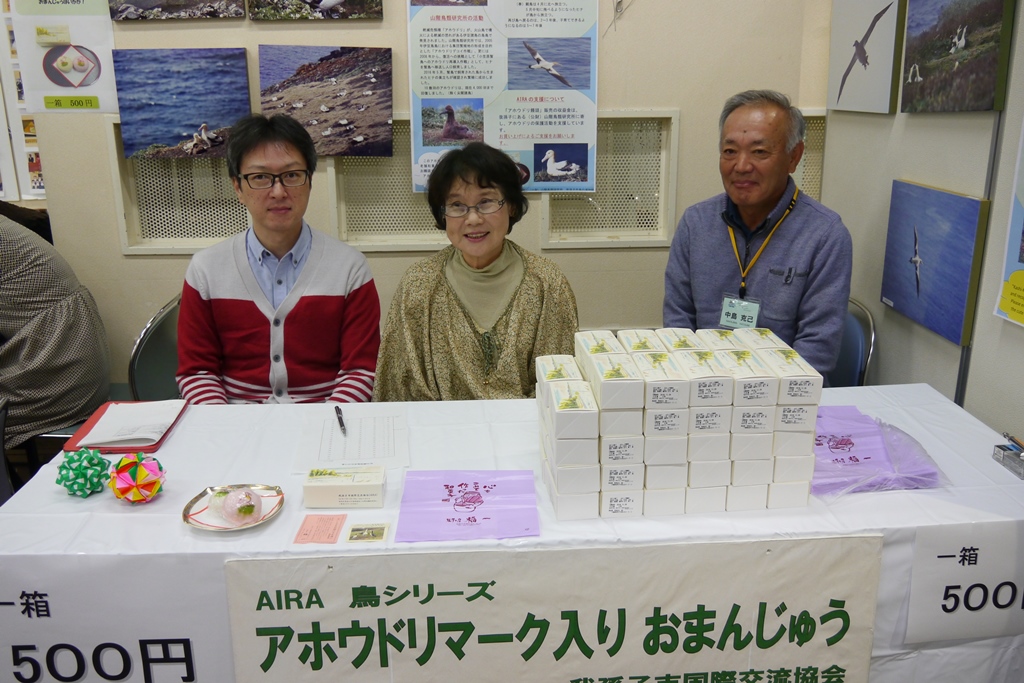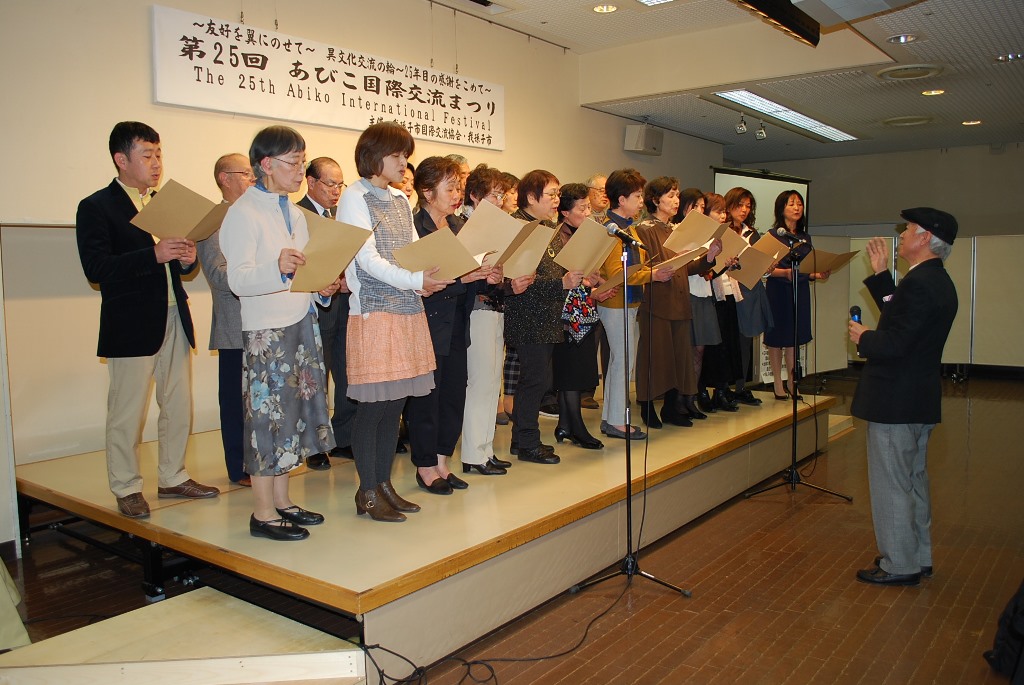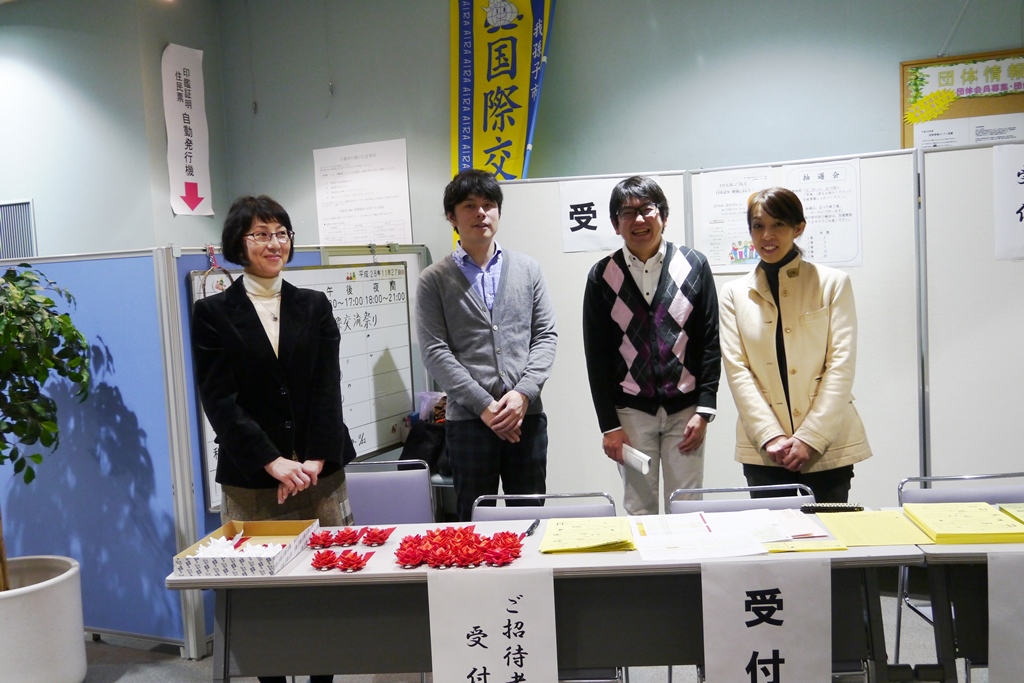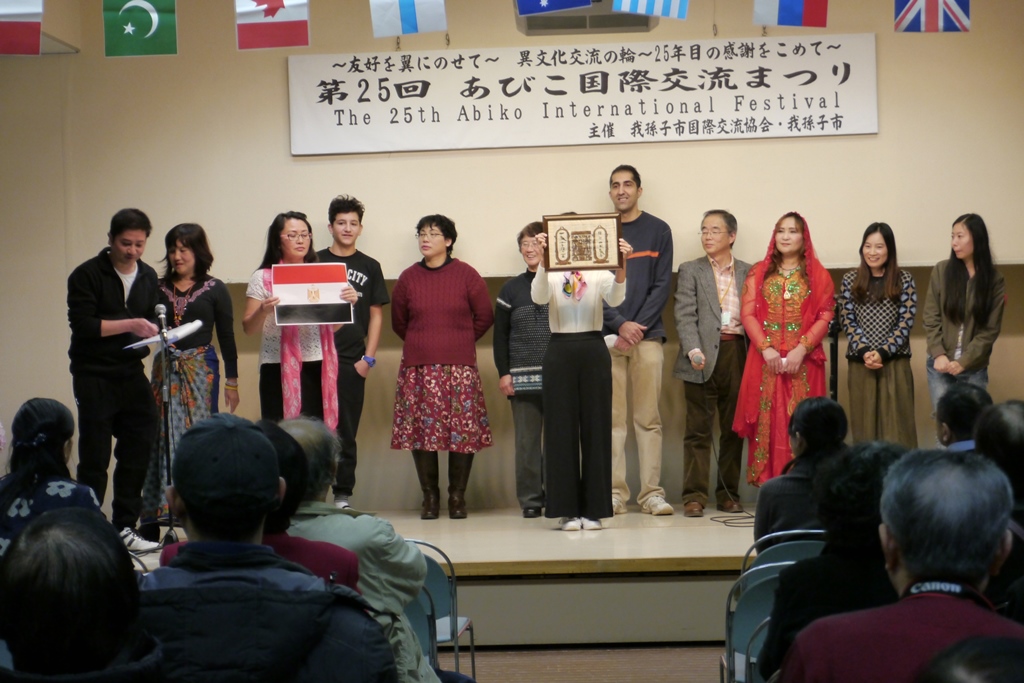The Memorial 25th Abiko International Festival

Date and Time: Sunday, November 27, 2016 11:00 a.m.~4:00 p.m.
Venue: Abiko Civic Plaza (3rd fl. Abiko Shopping Plaza)
Emcees: Mr. Mitsuru Hayasaka (chief of AIRA International Exchange Division) and Ms. Phyo Thiri Kyaw (Myanmar)
The 25th Abiko International Festival took place at Abiko Civic Plaza on the last Sunday of November. Co-hosted by AIRA and Abiko City, which has been trying to make Abiko a more foreigner-friendly city, the festival was held to provide opportunities for locals and foreigners to communicate each other. There were various events in the festival: Performances in the hall, shops of ethnic folk crafts and foods in the gallery, Japanese tea ceremony in the lobby, Kimono-dressing experience for foreigners in the Japanese room, etc.
This year falls on the 25th anniversary of AIRA founded on November 21, 1992, and the festival was held under the theme “With many thanks for the 25 years --- Let’s expand our circle of intercultural exchange!”
Winter came earlier than usual this year and it was a cold cloudy day. Prior to the opening of the festival, at 12:00 noon Filipino dance performances ”Carinosa” and “Tinikling” by a dance group “Carinosa Girls” were held at the main entrance of Abiko Shopping Plaza.
The members of “Carinosa Girls” are mothers from the Philippines, who got to know each other in Japanese language classes in Abiko and neighboring cities like Kashiwa and Soka. They formed the group to introduce their home country to Japanese people through Filipino dance and cooking.
“Carinosa” is a kind of folk dance which has been handed down since the time of Spanish rule and is deeply influenced by Spanish music and dance. The dancers performed the exotic and attractive dance with a folding fan in their hand.
“Tinikling” is what is called “bamboo dance”, performed using two bamboos. The dancers danced and jumped lightly between and outside the two bamboos. They danced like small birds flying around bamboo traps handmade by rice farmers or tree branches. After their performances the dancers invited the audience to join them and both adults and children enjoyed dancing together.
- Performance at the Hall
The tea ceremony started in the lobby at 10:00 a.m. and so did kimono dressing in the Japanese room. The shops in the gallery opened at 11:00. Stage events started at 1:40 p.m in the hall, since a ceremony celebrating the 25th anniversary of AIRA foundation was held prior to them.
With the opening words by the emcees Mr. Hayasaka and Ms.Kyaw the festival got started. The events on the stage are as follows:
- Hip-hop dance by “Kappa Dance Kids”, which consists of two dance groups, “Sparkle-kiz” and “Wonder Circus”. They are good at dancing “Kappa Ondo”, a local bon-dance song loved by Abiko people, in a hip-hop-style and sometimes invited to dance in events in communities to liven them up. On this day about fifty kids danced rhythmically together with the local mascot “Abika-chan”. All the people in the hall applauded the cute and powerful dancers.
- Hand-bell performance by“Bell Crane Ringers”
“Bell Crane Ringers” is a group of students at Kawamura Gakuen Woman’s University. They have been performing in various places from kindergartens and care homes in the neighborhood to Imperial Hotel, Makuhari Messe, including an overseas performance in Italy.
On this day they came to Abiko Civic Plaza just after they performed at Heiwadai Hospital in Abiko.
The sound of hand-bell is beautiful and clear, which is often described as “angel’s voices”. With each player handling two or three different hand-bells, they produced beautiful sound harmonizing every player’s heart together. Their performance was varied in the pitches and tempos, and their rhythmical sound echoed in the hall and impressed the audience. They played “Country Roads” “Tonari no Totoro” “Sanpo” “Canon” “The Phantom of The Opera” and “Rondo Passacaglia”. The last one was played under the conduct of their teacher.
c.Taiwanese Folk Dance
A group of four women, 游愛玲 (Taiwan, leader), 孫暁格 (China), Marina Ueki (the Philippines) and Nguyen Thi Nho (Vietnam) performed a harvest dance of Ami Tribe, one of the Taiwanese ethic groups. Ami is a matrilineal society and they are a merry and friendly people. Their dance is also cheerful and lively.
The song “Ami Qia Qia” was danced elegantly to the melody of a Japanese popular song “Hoshifuru Machikado” and the other song “Ami Sanho” is about a woman who sends her husband or boyfriend to war, but the dance was rhythmical and gave a cheerful and bright impression. This may be because of Ami people’s cheerful character.
d.Performances by AIRA Japanese Language Class students
1) Saturday Class students appeared on the stage dressed up in kimonos and their countries’ folk costumes, sang “Sekai no Kunikara Konnichiwa (Hello from all over the world)”. They also introduced how to say “Konnichiwa” in ten languages; Canada, China, France, India, Indonesia, Korea, Pakistan, the Philippines, Taiwan and Vietnam. Let’s bear in mind to remember these words when we go overseas.
2) Tuesday Class students gave a quiz show under the title “Which Country Are You From?” They gave questions showing their national flags and items from home. Some students were dressed in their folk costumes. The questions were from six countries; China, Canada, Egypt, Indonesia, Uzbekistan and Bhutan. It’s necessary to learn about other countries before we try to make ourselves understood.
e. Performances by AIRA Foreign Language Class students
1) French Class students sang a chanson “Under the Sky of Paris” to the piano played by one of the students, Ms. Matsumoto. It was the first program of the festival following the 25th anniversary ceremony, and its gentle and light melody was a bridge suitable for linking the ceremony and the festival.
2) Chinese Class students who learn from teacher 孫勉, sang Theresa Ten’s “月亨代表我的心”. While the audience was listening to the song, photo slides were shown of Chinese towns that were taken by a student in the class. After the song they gave some Chinese Quizes. The audience looked at Chinese characters on the screen and answered names of Japanese companies and products. 可果美龟甲万优衣库星巴全家便利商店(Family Mart), 格力高麦当劳(McDonald’s) and 尼桑汽车
3) Korean Class students who learn from Ms. Kim Jinam sang two songs, a Korean song “Tong-mu(friends)” and a Japanese song “Ue wo muite aruko (Let’s walk looking up at the sky, or popularly known as Sukiyaki)” in Korean to the piano accompaniment by Ms. Ushikubo , their classmate. It was a lively stage performance. Some students were dressed up in Chima-Jeogori, Korean traditional clothes, and a surprise appearance by exchange students from Korea amused the audience.
2. Gallery
a. Shops
In the gallery, shops of six countries (Korea, Germany, USA, China, France and Portugal) sold folk crafts and foods which expats living in Abiko had got during their home leave. Before 11:00 p.m. the gallery was already filled with people waiting for the opening of the shops. There were rare items which are hard to come by in Japan and foods from shops and restaurants run by some expats were sold at cheaper prices. Coffee and tea were served for free and people from various countries talked to each other in their languages in an international atmosphere.
b. Kids Section
Three students from Kawamura Gakuen Woman’s University were looking after small children who visited the festival with their family. They were enjoying “origami” and picture coloring together. This year more children visited the festival than last year.
c. Portrait Section
Next to the Kids Section, there was Portrait Section, which opened for the first time this year. The artist was drawing pictures of visitors. Up to two people were drawn in one picture, but for parents with a child he drew a picture of three people. It took 20 ~30 minutes to finish one picture and all the people who got their portraits looked very much satisfied.
d. Ahodori Manju Shop
At the entrance of the gallery “Ahodori (albatross) Manju (Japanese sweet buns)” are sold every year. AIRA is supporting the activities for the preservation of albatrosses by the Yamashina Institute for Ornithology in Abiko City. The institute, which has been working to protect and preserve albatrosses, is now trying to establish new breeding grounds for them in Ogasawara Islands. In order to support these activities, AIRA consigns making of “Ahodori Manju” to a Japanese confectioner in Abiko, sells them in AIRA Festival and donates the profits to the Institute every year. This year they were all sold out again following last year thanks to the cooperation of the visitors and staff members.
3. Tea Ceremony
The tea ceremony which was hosted by Ms. Soyu Okada, master of Omote-Senke, one of tea-ceremony schools, started a little past 10:00a.m., and the lobby was soon filled with many people who came to enjoy tea. This year four junior high-school students who learn tea ceremony from Ms. Okada at school were working as assistants and carrying tea bowls to the guests.
4. Kimono Dressing
In the festival foreigners can experience wearing kimono if they make a reservation in advance. This year 33 foreigners applied. Ms. Keiko Taguchi, kimono dressing teacher and her assistants made pairs and dressed 25 people (19 women and 6 men). Attired in beautiful kimonos, they were delightfully taking pictures here and there in the festival site.
At the entrance of the gallery there was a flower arrangement by Ms. Shunko Iwai. It was a beautiful arrangement using a water-wheel as part of it. Foreigners in Kimono posing for camera in front of the flower arrangement looked very nice.
5. Closing and Lottery Drawing
Mr.Hesaki, director of the festival, expressed thanks to all the people who had been preparing for the festival to make it successful since June. After that there was a lottery drawing. The prizes, some of which were rare items hard to come by, were donated by AIRA supporting members; the Yamashina Institute for Ornithology, Chuo Gakuin University, NEC, Abiko City Office, Bird Museum and Mr. Tierry (AIRA member).
The total number of visitors including those who were present at the AIRA 25th Anniversary Ceremony was 1,055, marking a new record of the AIRA Festival.
(No. 16-23 Translated by Ch. Yamaguchi)








